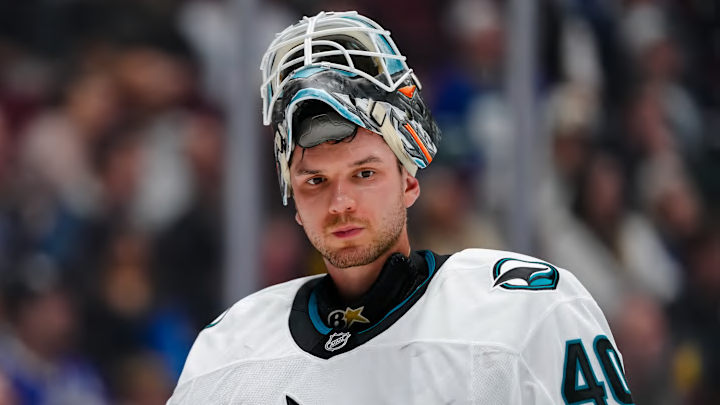The last thing a team wants to hear as the regular season approaches is that its goaltending is compromised. That was precisely the challenge confronting the Buffalo Sabres when Ukko-Pekka Luukkonen went down with an injury. To complicate matters further, the team signed Alexandar Georgiev to a one-year, $825,000 contract.
The 29-year-old split last season between the Colorado Avalanche and the San Jose Sharks. After three inconsistent years in Colorado, he was dealt to one of the league’s weakest clubs in exchange for Mackenzie Blackwood and Givani Smith. Yet even the Sharks — who have finished at the bottom of the standings in back-to-back seasons — chose not to keep him.
Georgiev is the second goaltender Buffalo has added this offseason, following former Detroit Red Wing Alex Lyon, who signed a two-year deal worth $1.5 million annually in July. The moves reflect a team scrambling to patch a critical position, though the logic behind these signings raises questions about strategy and resource allocation.
Sabres turned to Alexandar Georgiev out of desperation
At 26, Luukkonen carries a significant injury history with hip surgery in 2021 and ankle surgery in 2023, though he had remained healthy for the past two seasons until this latest setback. The Sabres have provided few details about the nature of his current injury, but their decision to sign another goaltender is at least a cause for concern.
Still, Buffalo’s approach represents a questionable allocation of resources. The $825,000 spent on Georgiev may not seem substantial in the grand scheme, but it carries value.
Georgiev struggled mightily last season, starting 49 games with a 3.71 goals-against average and an .875 save percentage. He ranked 65th in the league in goals saved above expected, marking his second consecutive season below the .900 save percentage threshold and above a 3.00 goals-against average.
Defenders of Georgiev often cite his 2022–23 season, when he posted a .919 save percentage, a 2.53 goals-against average and five shutouts. Yet, context matters: he was playing behind the reigning Stanley Cup–winning Avalanche and one of the league’s most elite offensive units, including Nathan MacKinnon, who produced a career-high 140 points. Once injuries and defensive lapses emerged, Georgiev’s limitations became obvious to even the most casual viewer.
The Sabres, facing desperation, turned to Georgiev for his NHL experience. The rationale is understandable, but not strictly necessary — the organization already possessed a viable option ready for promotion from within.
Devon Levi offered Buffalo a smarter path forward
Devon Levi sits next on Buffalo’s organizational depth chart. The 23-year-old spent the bulk of last season in the AHL, yet in nine NHL appearances, he posted a 4.12 goals-against average and an .872 save percentage. Georgiev’s numbers were marginally better, but it’s important to note that Georgiev benefited from a full season of work, whereas Levi’s NHL sample was limited.
From a strategic standpoint, promoting Levi to backup Alex Lyon would have made more sense. A young goaltender already embedded within the organization offers potential for growth and improvement, whereas Georgiev’s career has been marked by inconsistency. While neither option is perfect, the choice seems clear: invest in the developing talent cultivated over three years rather than a player more likely to introduce more problems.
The additional $825,000 spent on Georgiev could have left nearly $6 million in cap space for the Sabres — resources that could have been directed toward shoring up defensive depth or adding offensive firepower.
In the end, the decision to bring in Georgiev projects less as a calculated move and more as an act of desperation to patch a vacancy. Rather than demonstrating faith in their emerging talent, the organization chose to invest in a player whose track record suggests he is more of a liability than an asset.
